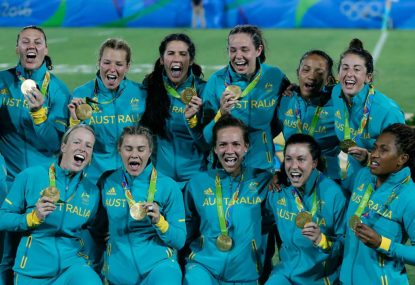'Doesn't count for anything': Bernie gets serious with Brumbies as race for top two finish heats up
The in-form ACT Brumbies have returned from their bye week raring to go and more mentally switched on than they've been all year, Stephen…

About a month ago, The Roar’s Geoff Parkes posted an intriguing proposal detailing his vision of a high-octane three-week sevens concept modelled largely off the Big Bash League.
Personally, in the direct aftermath of the Olympics and the world-beating performance of our women’s team, now could be the time for the necessary big thinking Geoff adopted within his article.
Sevens is fast, athletic and exciting. More importantly, much the same as T20 is made for TV in terms of cricket, so is sevens when it comes to rugby. Like T20, it thrives as an event. The BBL is a six-week bonanza of boom crash cricket. Sevens has the same potential. Importantly, it could provide the ARU with similar benefits that the BBL has for Cricket Australia.
Most notably, it would result in more eyes on the game, both in homes and at grounds, and an influx of funds. Funds they then use to support other existing structures.
But that’s not the only benefit. Rugby is as much about the participation in the game as it is anything else. Sevens is no different. As much as it can and is a product of mass entertainment, it can just as easily be a product of mass participation. Some may declare that we need to chose one or the another but, if done correctly, in a manner that’s inclusive and fun while also providing that link between the participation levels to that of say, the proposed ‘Sevens Rugby Smash’, we could create a system that will benefit the game as a whole.
So how do we do it?
Well, much of the structure has already been developed in the form of sevens competitions developed by the likes of the Brisbane and Sydney Junior Rugby Unions. For the sake of this article, I’ll be using the one I have read most about: the BJRU’s sevens program.
This program is a six-week (plus finals) competition that offers participants the opportunity to play two games each week either on a Friday evening or Saturday morning, depending on their preference. While this structure is geared toward children, it does provide a solid template for adult athletes both social and competitive.
Using this format to establish sevens competitions based in and around geographic regions (for example in Sydney you could have north, south, east, north-west and so on as well as larger country regions) with two distinct divisions within each region. The first would be the social division.
Part of the structure’s primary purpose should always be to provide access to social players who want to participate in fun, open and semi-competitive environments. This division will be solely directed at that aspect. Additionally, within this division there will be further distinctions between single-sex teams and mixed social teams, with the latter employing the Viva 7s format.
The second division would be the ‘open’ or ‘elite’ division. Part of the great success of the Aussie women’s squad was its ability to identify and recruit athletes from other sports. That will be the primary objective behind this division. It will be open to both men and women who are looking to try their hand at achieving the Olympic dream.
Part of participating in this division will be declaring your eligibility to participate in ‘regional select sides’ that will participate in each state’s respective ‘State Championship’ tournament against the premier clubs within each state. In order to ensure as wide of a range of participation as possible, state representative sides from the Northern Territory, South Australia and Tasmania (if they choose to enter) will compete in the West Australian (NT) and Victorian (SA and Tas) State Championships.
These events are where the link between the participation and professional approaches merge, as these events would serve as ideal recruitment opportunities for franchises if something like the ‘Rugby Sevens Smash’ was to be established.
Beyond the State Championship, the top three teams from both NSW and Queensland and the top two from the ACT and Southern New South Wales, Victoria and Western Australia regions will then progress to the National Championship to crown the best ‘amateur’ team in the country.
Finally, the question as to time frame for this theoretical competition should be addressed. To put simply, the initial phase should run during the National Rugby Championship window. I used the six-week length as an example but the beauty of these developed programs is their flexibility. They can be six or eight or even ten weeks long if the participants wish.
There’s also the ability to use them as a means of covering largely populated regions while also allowing far more sparse regions to run their own competitions.
Beyond that, the State Championships could run alongside the NRC finals (we could even have games both before and after the NRC semi-finals played at the same locations) with a similar arrangement for the National Championship. This would then give the franchises participating the ‘Rugby Sevens Smash’ the opportunity to assemble and train their respective squads.